

TESOL Webinar: Mobile Learning for Language Learners, Pedagogy and Lesson Plan Resources. iTDi Learning to Go course with Shelly Terrel. iPad Apps for English teaching and learning. In our prospective iPad project in our English and Media faculty we are currently trailing the best apps to use in the teaching of English and Media Studies.
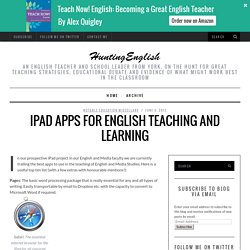
Here is a useful top ten list (with a few extras with honourable mentions!) : Pages: The basic word processing package that is really essential for any and all types of writing. Easily transportable by email to Dropbox etc. with the capacity to convert to Microsoft Word if required. Safari: The essential internet browser for the iPad for all required research essential to presentations etc. Dropbox: The best Cloud app to save work and create an accessible area to share work, ideas etc. Mobile ESL Learning. Teaching with Apps. iPads for ELLs: Enhancing Critical Thinking. Here are the highlights from the workshop “iPads for ELLs: Enhancing Critical Thinking” which we co-presented at the 2011 Long Island Tech Summit on October 18th.
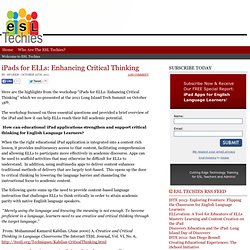
The workshop focused on three essential questions and provided a brief overview of the iPad and how it can help ELLs reach their full academic potential. How can educational iPad applications strengthen and support critical thinking for English Language Learners? When the the right educational iPad application is integrated into a content rich lesson, it provides multisensory access to that content, facilitating comprehension and allowing ELLs to participate more effectively in academic discourse. Apps can be used to scaffold activities that may otherwise be difficult for ELLs to understand. In addition, using multimedia apps to deliver content enhances traditional methods of delivery that are largely text-based.
“Merely using the language and knowing the meaning is not enough. Assessment and iPadology. Aligning course goals with a course, is often left out of the hands of educators who work at institutions, (or at least where I am currently located – in other locations, I both designed and developed the assessment format of a course).
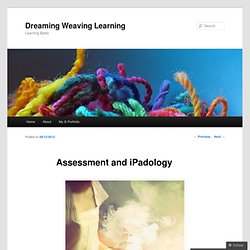
However, as I also mentioned in my previous post, personally speaking, I have always had a handful of marks which I could give to learners according to what I thought was relevant. Most of the times, these marks were awarded for continuous assessment – not only a presence in the classroom, but collaboration and fulfillment of tasks. As a language teacher, project-based learning is not new to me – for years I have practiced what is known as task-based learning – not only learning a language, but learning it through intelligent tasks where students could use the language and skill outside the classroom.
Nevertheless, my greatest challenge at the moment, is finding a balance within the assessment formats I am given to follow. Free Apps to Support Vocabulary Acquisition by ELLs. One of my favorite aspects of integrating technology into instruction is the availability of resources to support students with different learning needs.
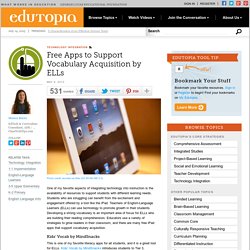
I Know - Quiz Creation App for iPad on the iTunes App Store. Mobile. Archive I wanted to take a closer look at the iPad Evaluation I previously blogged about in Evaluating Apps with Transformative Use in Mind. The section of Content and Components deserved a closer look and explanation. You can download the PDF file of the iPad App Evaluation for the Classroom with the following sections of evaluation included: ConsiderationsContent & ComponentsLogisticsFluencySubstitution vs Transformation Model (based on SAMR model of Ruben Puentedura and Alan November‘s work)Evidence of Learning (based on conversation with Stephen Wilmarth) After looking at iPad apps through the lens of Gardner’s Multiple Intelligences, November’s Digital Learning Farm, 21st century Upgrades, let’s take a closer look at the content and components of these apps.
It is important to remind ourselves that shiny visuals and audio not automatically translate into pedagogical value of the program. The BookCreator app is not designed for a school environment only. Mobile Learning for Language Teachers: Resources & Lesson Plans. Audio and Video ESL Lessons - English as a Second Language (ESL) Podcast - Learn English Online - English4Today : Learn English With Video. It’s really not complicated, guys: Don’t drink and drive. American TESOL Institute's Mobile Website. Non-Flash Things for ESL/EFL Students (iPad, iPhone, etc.)
Mobile English. By Nicky Hockly and Gavin Dudeney Technical wizards Nicky Hockly and Gavin Dudeney present a series of lesson plans on using mobile phones in class, suitable for any device from the most basic phone to the latest smartphone.
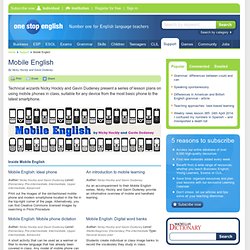
Mobile English: Ideal phonePrint out the images of the old-fashioned mobile phone and modern smartphone located in the file in the top-right corner of the page. mLearning in ELT. 1 year English course starting at one dollar. Terakki - Google Play. Learn a language from life. SnaPanda - Android application. M & M Lite. Eltchat [licensed for non-commercial use only] / How do you use mobile devices in the classroom Tips, apps, best practices. ELT Chat Summary - 30th April How do you use mobile devices in the classroom?
![eltchat [licensed for non-commercial use only] / How do you use mobile devices in the classroom Tips, apps, best practices](http://cdn.pearltrees.com/s/pic/th/commercial-classroom-practices-49473100)
Tips, apps & best practices Introduction This was the initial question for the evening's discussion, although there was some debate about the definition of mobile devices. Some people suggested digital cameras, laptops, tablets – there are also dictophones and digital video cameras. Uses of mobile phones for the classroom eventually became the main focus, although I felt that the chat roamed around a number of areas, including the possibilities for use, teachers' feelings, issues and potential problems and useful apps. I would like to point out that I was asked, ever so politely, to do this summary because of my summarising tweet... A journée in language. Julie’s story: ELT Freelancing in France for over 30 years This past week I met Julie Cummings-Debrot, a freelancer with her own company here in Paris – for a cup of coffee and a chat about teaching in France, corporate training and how she’s incorporating blended learning into her courses.
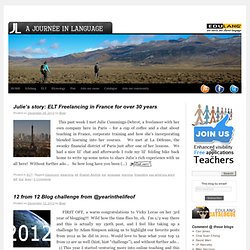
We met at La Défense, the swanky financial district of Paris just after one of her lessons. We had a nice lil’ chat and afterwards I rode my lil’ folding bike back home to write up some notes to share Julie’s rich experience with us all here! Without further ado… So how long have you been (…) Posted in ELT | Tagged classroom, elearning, elt, English Addicts, esl, language, learning, linguistics, pay what you want, tefl, tesl, tesol |2 Comments 12 from 12 Blog challenge from @yearinthelifeof FIRST OFF, a warm congratulations to Vicky Loras on her 3rd year of blogging!!! The Value of Knowledge Today is on the Decline. Apps n’ Dogme « languagemoments. Phil Wade To cut a long story short I’ve recently taught some 121 classes with ipads n’ apps.
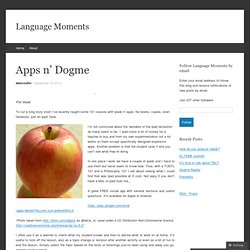
No books, copies, even handouts, just an ipad. Now, Language learning for busy people · OpenLanguage. Apptiviteiten Home »Apptiviteiten. Mobile Learning: 50+ Resources & Tips. I believe mobile devices will transform education. This is why I created a free ebook, Effective Mobile Learning: 50+ Quick Tips & Resources with helpful tips and several resources to help support this trend. One reason is because mobile devices are designed in a way that forces the teacher to give control to the learner. When we equip a classroom with iPads, iPods, small tablets, or cellphones the learning is literally put in the hands of the students.
The teacher has to facilitate and walk around the room to manage the learning. MobileLearning. Presentation brought to you by American TESOL! Check out their other video presentations! Click here for the resources, post & recording Talking Tom. TechnoLanguages - iPod Touch & iPad Apps.